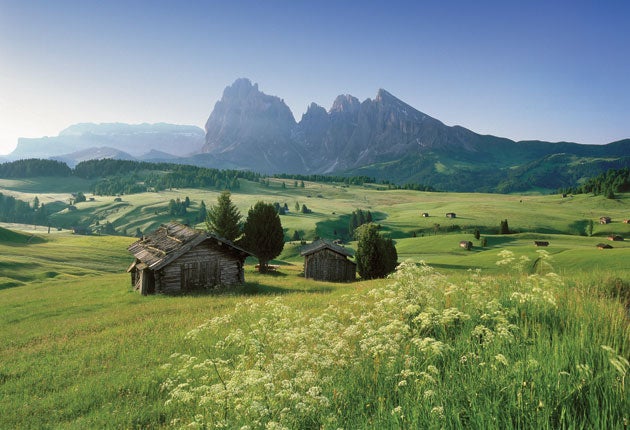Italy's peaks of perfection are in the Dolomites
The walking can be tough, but Jeremy Laurance felt on top of the world in these mountains

Your support helps us to tell the story
From reproductive rights to climate change to Big Tech, The Independent is on the ground when the story is developing. Whether it's investigating the financials of Elon Musk's pro-Trump PAC or producing our latest documentary, 'The A Word', which shines a light on the American women fighting for reproductive rights, we know how important it is to parse out the facts from the messaging.
At such a critical moment in US history, we need reporters on the ground. Your donation allows us to keep sending journalists to speak to both sides of the story.
The Independent is trusted by Americans across the entire political spectrum. And unlike many other quality news outlets, we choose not to lock Americans out of our reporting and analysis with paywalls. We believe quality journalism should be available to everyone, paid for by those who can afford it.
Your support makes all the difference.On the 400-mile drive from Nice across the north Italian plain, shimmering in the heat, we paused only once for a cooling dip in the glittering waters of Lake Garda. As we entered the uplands my spirits began to lift, as always. Five miles from our destination, we got our first view of the mountains – towering pinnacles of bleached rock sprouting from meadows of iridescent green, lit by the dying sun. Like giant monuments to an ancient world, they could not have seemed more alien.
The excitement that seized us that first night round the table of the Posthotel Lamm in Kastelruth was not merely the excitement of getting away on holiday. The hotel, to be sure, was warm and welcoming, and the food prepared by the 26-year-old head chef was remarkable – roast beef with gnocchi, consommé, a sorbet of banana and melon, and a starter of hot goat's cheese and roasted vegetables. And those are just the courses I can remember. By the third night, some of our party – eight friends in search of a sybaritic adventure – pronounced it the best four-star hotel we had stayed in anywhere.
No, what seized our imaginations was the prospect of getting in among those magical mountains (there are strong local beliefs in witches) exploring their valleys, scaling their summits – and then gorging ourselves at day's end. What could be better?
The Dolomites, renowned for their jagged peaks of pale, heavily eroded limestone, are little visited by the British but are popular in summer with Italians from the south taking refuge from the scorching plains.
This was the second outing for our gang, after the Pyrenees last year, walking between three hotels (with luggage carried) around the Sciliar plateau, Europe's highest, covering an area of 50 square miles, ringed by spectacular peaks. Each day there were four options for walks of different lengths and degrees of difficulty, guaranteeing almost permanent debate.
That first night, over glasses of grappa, we were in rebellious mood. None of the walks recommended by Inntravel, our holiday company, looked challenging enough. Encouraged by our barman, we considered striking off on our own to find a lake hidden in the forest which was glorious for swimming. Next morning, grappa-free, it dawned on us that the Inntravel walk we had rejected the previous night did actually include the swimming lake. We took it – about 12 miles circling the plateau through a succession of pretty villages under an azure sky, punctuated by a glorious swim in the lake, and dominated all the way by the Dolomite peaks.
Alles in ordnung (everything in its place) is the defining – and thoroughly unItalian – characteristic of this region. Though technically in north Italy, the Südtirol is ethnically, culturally and gastronomically Austrian. The villages and meadows were immaculate, from the luxuriant window boxes to the neat log piles.
Next day, we climbed the 8,000ft Sciliar and, after rewarding ourselves with brimming bowls of minestrone at the rifugio, we set off across the bleakly beautiful plateau in the direction of the Denti di Terra Rossa. We rounded a crest and entered an extraordinary canyon – the vertigo- inducing path hugging the precipice on one side while, opposite, a grey curtain of folded and fissured rock 1,000ft high hung suspended – like the fabric of creation. As we gaped in awe we had to press ourselves against the wall to make way for two cyclists.
The best was still to come. For our last day, ignoring jibes from some party members about the "tyranny of accomplishment", we tackled the Platt- kofel – a giant slab of rock jutting almost 10,000ft over the side of the plateau, seemingly hanging in space. The route up involved zig-zagging over shale and rock, blindingly white in full sun. At the top we peered gingerly over the edge. Across the canyon, where jackdaws wheeled in the icy wind, columns of rock soared skywards for 3,000ft. It was epic, magnificent, awesome – and terrifying. There was not a lot of room on the summit and columns of walkers were coming and going. We sat, sliced apples and stared at the horizon. We were on top of the world – which is exactly how we felt.
Compact facts
How to get there
Jeremy Laurance travelled with the walking specialist, Inntravel (01653 617906; inntravel.co.uk), which offers a week's independent walking in the High Dolomites of the Südtirol from £635 per person, based on two sharing. That includes half-board in four-star hotels, walking maps, notes, and luggage transfers between three hotels. Rail and taxi transfers from Verona airport cost £110 per person with Inntravel. Flights, rail travel or ferry crossings can be arranged.
Join our commenting forum
Join thought-provoking conversations, follow other Independent readers and see their replies
Comments